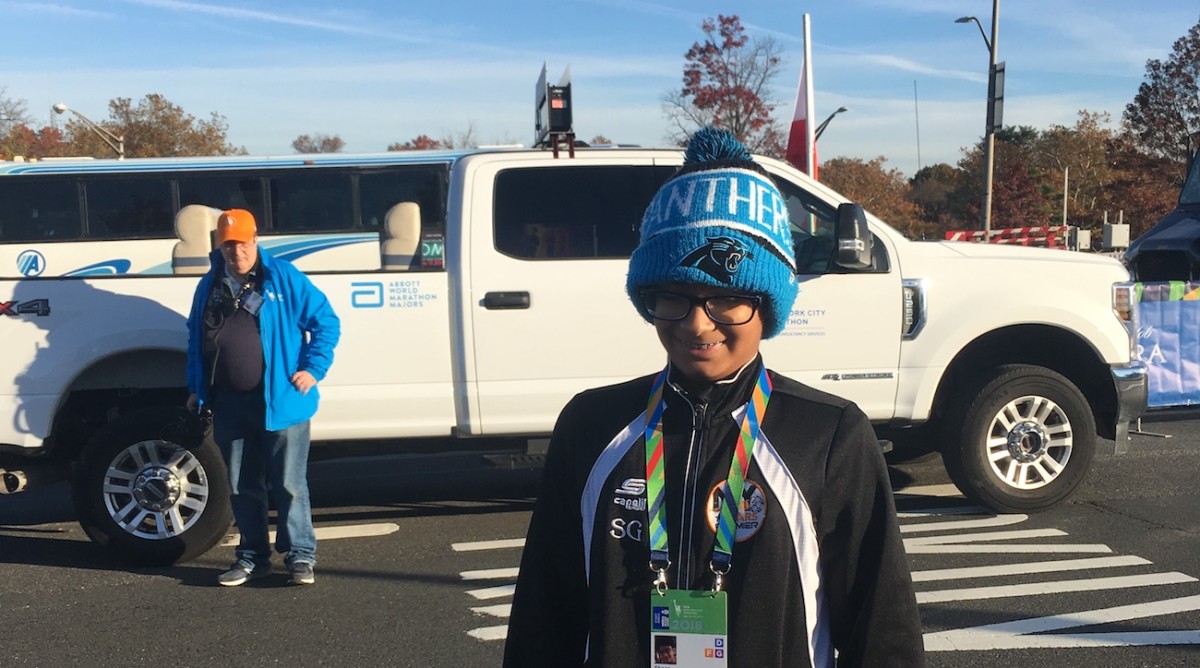My Day Covering the 2018 New York City Marathon

Sunday was the 48th running of the New York City Marathon, a 26.2-mile race that runs through each of the five New York boroughs. Athletes from all over the world fly to the Big Apple to participate in this great tradition. In 2018, the race had more than 50,000 participants representing more than 130 countries. I was at the starting line before the marathon began, in the lead vehicle for the men’s wheelchair race, and at the finish line when the first athlete, Daniel Romanchuk, arrived.
Romanchuk, who also won the Chicago Marathon last month, became the first American in history to win the NYC Marathon’s men’s wheelchair race—and he did it by .01 of a second! “It's an amazing experience to be able to win two major marathons in a row,” he said afterward. “It still hasn’t sunk in yet.”
Switzerland’s Manuela Schär edged out five-time winner Tatyana McFadden of the U.S. in the women’s wheelchair race; Mary Keitany of Kenya beat the field of elite women runners for the fourth time, and Lelisa Desisa of Ethiopia led the men.
I am a native New Yorker, and one of the best parts of the day was traveling through all the different neighborhoods of the five boroughs; it definitely gives you a sense of the diversity that makes New York so special. And along the way, even at 8:30 in the morning in the cold, crowds were lined up cheering on the athletes. It made me proud to be a New Yorker.
I’ll tell you about my day. I woke up at 4 a.m. and got to the media staging area at 5 a.m. My only description of the earliest hours was that it was still dark and cold outside, in the low 40s. We were taken by bus from Times Square to Staten Island, which is the starting point of the race. I then went to the (warm) media tent, where I met members of the local and foreign press and spoke to them about their experiences covering the marathon. I also met with members of New York Road Runners (NYRR), who organize the event and who explained everything I needed to know about the race.
After 45 minutes of waiting in the tent, it was race time. I was taken to the starting line, where I watched the organizers get ready, as well as members of the New York Police Department, the New York Fire Department, the armed forces, and other first responders get ready for the opening ceremonies. I then climbed into the bed of the truck that served as the lead vehicle, and it was go time!

The men’s wheelchair race started at 8:30, and it was the perfect fall New York morning (although still cold in the open-air truck). My truck was the first to leave the starting gate. The two main purposes of the lead vehicle are to keep the unofficial time on a giant display that sits on the roof of the truck and to protect the athletes. We had to stay far enough away from them so that we weren’t in their way, but also close enough so that no one crossed the street in front of them after we passed by.
Also alongside the athletes were cyclists who used whistles and protected the athletes from pedestrians who dared to cross the street in front of the athletes and risk injury. I noticed those cyclists had their hands full. You’d be surprised how many people tried to cross the street as the athletes were approaching. The cyclists also had the job of alerting the people in the lead vehicle if they have appropriate spacing or if they are going too fast or too slow. This is key because the wheelchair athletes have an amazing speed, and the cyclists’ job is to make sure no one gets too close to them.
In terms of the competition itself, three men displayed their expert racing skills by pulling away from the rest of the pack almost immediately: Romanchuk, David Weir, and Marcel Hug. By Mile 3, these three were well ahead of the others and stayed that way throughout the duration of the race. Romanchuk was in the lead for the first five miles, keeping a steady pace throughout. However, towards the ninth and 10th miles, I started to see a technique that uses science to make the tough 26.2-mile race a little bit easier: drafting. Drafting is when two or more competitors stay in a straight line to conserve energy and feed off each other’s work, which means that the competitors in the back use the wind resistance from the person in front to decrease the amount of friction in the air and therefore spend less energy.
For example, I noticed that Weir and Hug stayed behind Romanchuk for the first five miles, which allowed the two in the back to conserve energy and use Romanchuk’s work to propel themselves forward. However, towards the end, Romanchuk was using the drafting technique, and that helped propel him to a .01 of a second win over Hug and a .02 of a second win over Weir.
I also noticed that the athletes did not “pump” or spin their wheels on the downhills because doing so might make the athletes lose control, particularly on the sharp turn coming off the Queensboro Bridge onto First Avenue.
At the end, it was such an exciting race and all three were within inches of each other at the finish line, with Romanchuk winning and making history!
Top photograph by Timothy A. Clary/AFP/Getty Images
